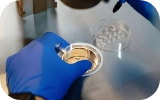Hydrosalpinx

Hydrosalpinx is a condition that leads to a blockage in the fallopian tube(s). Generally, females don’t know if they have this condition and only find out about the disease when they consult a fertility specialist for fertility issues. Females who have hydrosalpinx generally opt for IVF treatment after getting the condition treated.
Are you curious about this condition? Learn more about hydrosalpinx here.
What Is Hydrosalpinx?
Hydrosalpinx is a medical condition that affects the reproductive system of a female. In this disease, fluid accumulates in one or both the fallopian tubes and creates a blockage. It usually occurs because of an injury or an infection and causes distally blocked fallopian tube(s).
Women with hydrosalpinx experience infertility as the sperm is not able to fertilise the egg in time. Even if the sperm managed to fertilise the egg in time, a successful pregnancy is not possible with hydrosalpinx as the embryo will not be able to travel to the uterus to implant itself.
How Common Is Hydrosalpinx?
Data suggests that about 20-30% of all infertility cases are related to tubal factor infertility or a problem with the fallopian tubes. Out of these 20-30% cases of infertility, hydrosalpinx is the cause behind 10-20% of the cases.
Your doctor will likely use diagnostic tools to rule out the possibility of hydrosalpinx during your fertility assessment before your start any fertility treatment.
Who Can Get Hydrosalpinx?
Women who have experienced sexually transmitted diseases, injury, or surgery affecting the fallopian tubes can develop hydrosalpinx. It is not an uncommon condition.
Hydrosalpinx Symptoms
Symptoms of hydrosalpinx are usually non-existent. Many people don’t realise they have hydrosalpinx until they experience infertility and consult a fertility doctor. In some cases, females with hydrosalpinx may experience pelvic pain that worsens during or immediately after your period and discoloured or sticky vaginal discharge.
If you have undiagnosed, untreated hydrosalpinx you may risk the following:
Ectopic Pregnancy
A female with hydrosalpinx can have a fertilise embryo implant itself outside her uterus (ectopic pregnancy) in the pelvic region in some cases. Ectopic pregnancies are not viable and can become life-threatening without any treatment.
Infertility
Perhaps, one of the major side-effects of hydrosalpinx is infertility. With blockage in your fallopian tube, it becomes difficult to conceive as the egg will not be able to travel through the fallopian tube and implant itself in the uterine lining after fertilisation. It is more difficult to conceive with blockage in both the fallopian tubes in comparison to blockage in only one fallopian tube.
Low Success Rates of IVF
Females who have hydrosalpinx and go through IVF treatment may not get pregnant or have complications in their pregnancy. This is because the fluid from a hydrosalpinx in the fallopian tube can flow backwards into the uterus in some cases and create an unhealthy environment for embryo or foetal development.
Hydrosalpinx Causes & Risk Factors
One of the most common causes of Hydrosalpinx is an untreated infection. The infection can cause inflammation in the fallopian tube near the ovaries where the fimbriae; finger-like extensions of the fallopian tube that sweep an egg from the ovaries are called fimbriae. The fimbriae may fuse together during healing and seal the fallopian tubes. This causes fluid to trap inside the fallopian tubes and make them swell.
Some of the other causes of hydrosalpinx are listed below:
- Gonorrhoea, chlamydia, or other sexually transmitted diseases (STIs)
- Pelvic infections
- The build-up of tissues due to endometriosis
- Scar tissue from a previous tubal surgery
- Tubal tuberculosis
- Pelvic inflammatory disease (PID)
- Tumours
- Adhesions in the pelvic region
Hydrosalpinx Diagnosis
The following diagnostic procedures can help identify a blockage in your fallopian tube and identify whether it is hydrosalpinx or not:
1. Hysterosalpingogram (HSG)
This is an advanced X-ray that uses contrast material to check for blockages in the fallopian tube. An HSG is one of the most common tests that can help detect the presence of hydrosalpinx. If the dye spills out of your fallopian tubes, you don’t have any blockage, but if the dye doesn’t spill out, it indicates blockage in the fallopian tubes.
2. Ultrasound
An ultrasound can detect fluid build-up in the fallopian tubes, which are otherwise not visible on an ultrasound. This happens because the hydrosalpinx makes the fallopian tubes swell and appear larger than usual, like a sausage sometimes. An HSG may be recommended if your healthcare provider detects a hydrosalpinx.
3. Laparoscopy
This is a minimally invasive surgery that enables your fertility specialist to view the inside of your abdomen using a small camera inserted into your abdomen through tiny cuts in your belly. Laparoscopy may be used to confirm the results of an HSG test. After the confirmation of the presence of hydrosalpinx, the doctors usually proceed to either remove the blocked fallopian tube(s) or repair the blockage.
Hydrosalpinx Treatment
If you have hydrosalpinx, getting proper treatment can improve your chances of success. The treatment depends on different factors, such as the severity of your symptoms. Here are some of the treatment strategies used for hydrosalpinx:
1. Medication to Treat Ongoing Infection (If Any)
After diagnosing you with hydrosalpinx, your doctor will try to examine the root cause. If you have an active infection, the doctor will recommend antibiotics or other suitable medication to address it.
2. Salpingectomy
Treatment of hydrosalpinx usually involves the surgical removal of one or both fallopian tubes. This surgical process is called salpingectomy if only one fallopian tube is removed, and bilateral salpingectomy if both the fallopian tubes are removed.
The hydrosalpinx removal is a laparoscopic surgery that involves making keyhole incisions in the abdomen to remove the damaged tube. This procedure can lead to disruption in the blood supply to the reproductive organs.
3. Salpingostomy or Neosalpingostomy
This is the process of repairing the blockage in your fallopian tubes. This is also a laparoscopic surgery. A small hole is made into the fluid-filled fallopian tube to drain the fluid, relieve swelling, and remove blockage.
In Vitro Fertilisation (IVF) Treatment After Salpingectomy
After hydrosalpinx is removed, the affected female can opt for IVF for building her family. IVF involves the removal of mature eggs directly from the ovaries, fertilisation of eggs in an embryology lab, and transfer of embryos into the women’s womb.
With IVF there is potential no harm in carrying the baby if you hydrosalpinx has been removed as there won't be any more fluid build-up.
Summing Up
A condition that usually does not cause any symptoms, hydrosalpinx can be a huge trouble if you wish to get pregnant. For minimal damage, your fertility doctor will likely recommend draining the fluid, but for severe damage, they will recommend a salpingectomy to remove the fallopian tube.
Hydrosalpinx is usually not diagnosed until you go for a fertility assessment as there are generally no symptoms of the condition. Consult a fertility specialist from Nova IVF Fertility to know the cause of your infertility and get suitable treatment if you are having trouble conceiving.
FAQS About Hydrosalpinx
Q. What is hydrosalpinx meaning?
A. In Greek Hydrosalpinx means a tube filled with water. It is a medical condition that causes swelling and fluid build-up in the fallopian tubes, effectively blocking them.
Q. Can I get pregnant with hydrosalpinx?
A. There is a possibility that you may get pregnant with hydrosalpinx if only one of your fallopian tubes is blocked. In some cases, the sperm can travel through the blockage and fertilise the egg, but the embryo will not be able to implant itself in the uterus. In some cases, the fertilised embryo may implant itself outside the uterus and result in a potentially life-threatening condition called ectopic pregnancy.
Even if the fertilised egg is able to implant itself in the uterus, you may experience complications later in the pregnancy as the fluid from the hydrosalpinx can flow back into the uterus and create an unhealthy environment for foetal development.
Q. How can one get rid of hydrosalpinx naturally?
A. There is no natural way to get rid of hydrosalpinx; salpingectomy is the surgical removal of damaged fallopian tubes, and it is a usual treatment choice for hydrosalpinx. If there is minimal damage, your doctor may suggest draining the fluid by making a small incision.
Q. What is the impact of hydrosalpinx?
A. Hydrosalpinx can cause infertility and lead to an increased risk of pregnancy complications and miscarriage.
 Infertility Counselling
Infertility Counselling Female Infertility Treatment
Female Infertility Treatment Andrology Treatment
Andrology Treatment Fertility Enhancing Surgeries - Female
Fertility Enhancing Surgeries - Female Fertility Enhancing Surgeries - Male
Fertility Enhancing Surgeries - Male Endoscopy Treatment
Endoscopy Treatment IUI Treatment
IUI Treatment IVF Treatment
IVF Treatment ICSI Treatment
ICSI Treatment Advanced IVF Solutions
Advanced IVF Solutions Embryology
Embryology Vitrification Egg, Embryo, Sperm Freezing
Vitrification Egg, Embryo, Sperm Freezing Preimplantation Genetic Testing (PGT)
Preimplantation Genetic Testing (PGT) Donation Program Embryo / Egg / Sperm
Donation Program Embryo / Egg / Sperm Self-cycleTM IVF
Self-cycleTM IVF

 Self-cycleTM IVF
Self-cycleTM IVF







